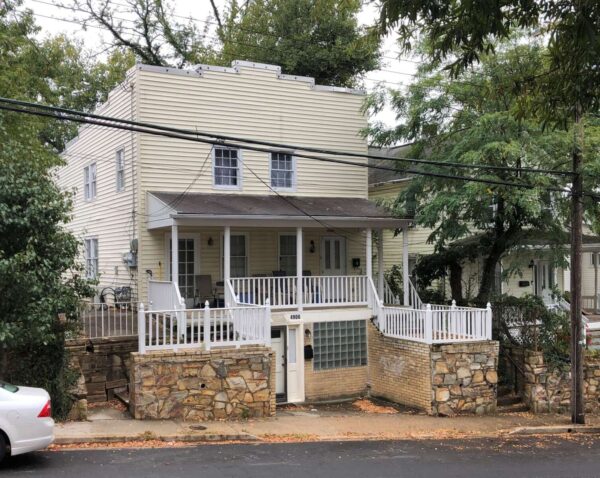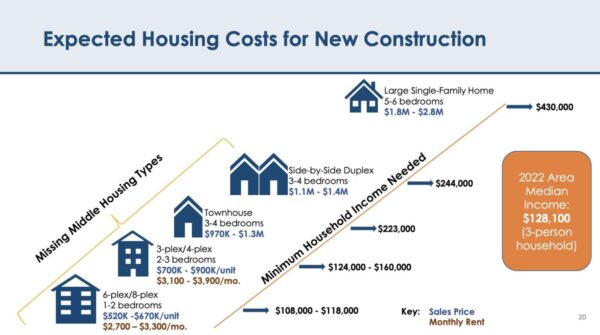
(Updated at 6:15 p.m.) The Arlington branch of the NAACP — previously a champion of Arlington’s Missing Middle housing proposal — is claiming the proposal now being deliberated is in danger of violating federal and state fair housing laws.
After hearing nearly 200 public speeches and convening three meetings in mid-January, the Arlington County Board approved a request to authorize hearings on proposed zoning changes that would allow small-scale multifamily buildings with up to six homes in districts zoned exclusively for single-family detached homes.
In so doing, the Board removed an option to consider buildings with seven or eight units and retained an option to impose higher lot size minimums for five-plexes and six-plexes outside of major transit corridors.
NAACP Arlington Branch President Mike Hemminger, Housing Committee Chair Bryan J. Coleman and Secretary Wanda Younger decried the move in a letter released yesterday (Thursday) to Arlington County Board Chair Christian Dorsey.
“The NAACP fiercely opposes these restrictions and urges the County Board to enact only the set of options that will supply our community with the highest number of attainable homes across all of Arlington’s residential neighborhoods,” they write. “The NAACP will not be a bystander as government policies recreate discriminatory effects of the past by preventing people of color from enjoying the same benefits as those living in the county’s wealthiest, whitest neighborhoods.”
Arlington County Board members say they support the zoning changes to partially undo the lasting impacts of housing policy decisions that excluded people of color from many neighborhoods, such as racially restrictive deed covenants, the decision to ban rowhouses — popular among Black people but deemed “distasteful” by local leaders at the time — and a physical wall white residents built to keep out Black people from the Halls Hills neighborhood.
But removing eight-plexes and entertaining lot size minimums are “land use policies that have significant, unjustified disparate impacts on people of color,” which the Fair Housing Act prohibits, the NAACP said.
These restrictions will result in more expensive new construction and create “unequal housing opportunities in the same neighborhoods from which people of color have long been historically excluded.”
These policies would result in more expensive new construction, they say, citing an Arlington County presentation indicating six- or eight-plexes would be attainable for households making $108,000 to $118,000, compared to the $124,000 to $160,000 needed for three- and four-plexes.

By its calculations, the NAACP leaders say, increasing the household income needed from $100,000 to $150,000 would result in some 44% of white households able to buy, compared to 20.3% of Black and 24.3% of Latino households.
That means the number of Black households who can afford Missing Middle homes would decrease by 43% and Latino households by 38%, compared to white households, 32%.
The issue of whether to allow seven- and eight-plexes split the County Board. Members Matt de Ferranti and Takis Karantonis and Vice-Chair Libby Garvey supported removing these options while member Katie Cristol and Chair Christian Dorsey did not.
De Ferranti has argued against it on the grounds that these are mostly going to be rental 1- and 2-bedroom properties, which are not the types of units that Arlington is aiming to build more of through Missing Middle.
But the NAACP maintains that this line of reasoning tacitly endorses “‘camouflaged’ racial expressions” made by members of the public.
A lengthy footnote summarizes such public comments from Missing Middle opponents, including statements like: “Our neighborhoods will have ‘more’ criminal activity with lower income people who will want what their neighbors have” and “density, and certain things and people that accompany density, are associated with crime and violence. I pay a price to live in a safe, not dense community and I don’t want to have to move again because the character of my neighborhood changes.”
Dorsey and Cristol argued removing seven- and eight-plexes capitulates to critics of the proposal — after the Board took steps to address their concerns — even as the most vocal critics still disapprove of the proposal, per statements released after the vote.
Critics have also maintained that Missing Middle will increase gentrification and have argued against the proposal on the basis that it will not create options that are affordable to many communities of color.
NAACP branch leaders say they cannot support the current proposal unless the Board at least allows six-plexes by right across all residential neighborhoods.
“To do otherwise would not only skirt the stated purpose of the Fair Housing Act but also continue to entrench segregation of Arlington’s neighborhoods that has persisted for nearly a century,” the letter says. “The NAACP also expects the County Board to keep its pledge to build on the proposal after its enactment, which must include legalizing seven-plexes and eight-plexes.”

